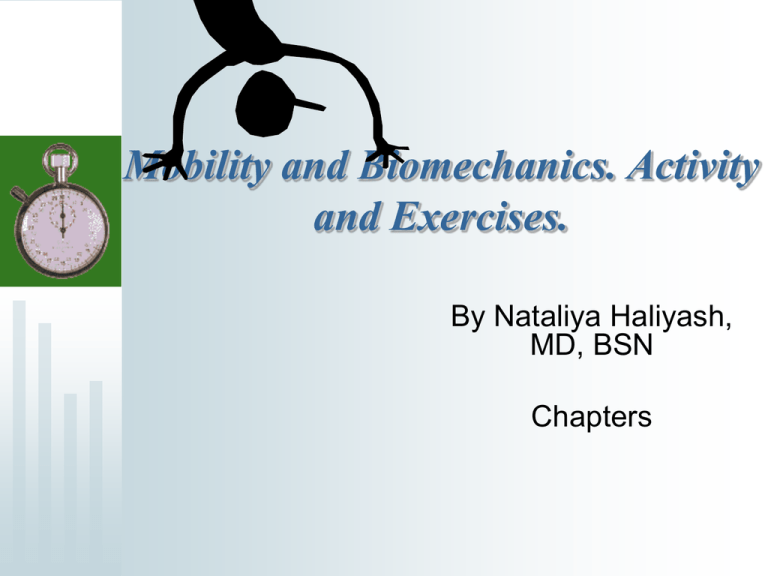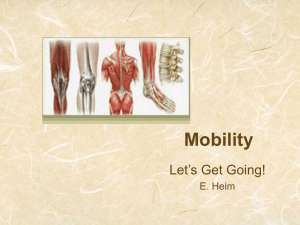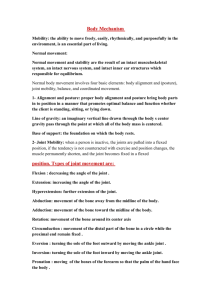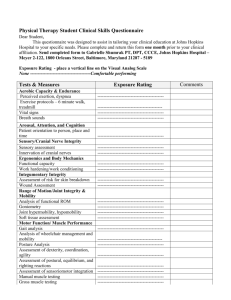Lecture 10 - Activity and Exercise
advertisement

Mobility and Biomechanics. Activity and Exercises. By Nataliya Haliyash, MD, BSN Chapters Lecture objectives: • • • • • • The role of musculosceletal and nervous systems in the regulation of movement Body alignment, body mechanics and joint mobility Learn how to maintain and use proper body mechanics Benefits of exercise and activity Planning an exercise program for clients across the lifespan Assess clients for impaired mobility and activity intolerance 2 Why is it important to know? • The action of walking, turning, lifting and carrying are essential components in the provision of nursing care. • To reduce the risk of injury to the client or nurse, the nurse must know and practise proper body mechanics. • Nurses must promote activity and exercise because beneficial impact on wellness, prevention of illness, and restoration of optimal functioning. 3 Body mechanics • Purposeful and coordinated use of body parts and positions during activity. • Involve three basic elements: – body alignment / posture, – stability / balance, – and coordinated movement. • It helps to maintain body alignment during lifting, bending, moving and performing activities of daily living (ADLs) 4 Body Alignment (posture) – Position of body parts in relation to each other along a horizontal or vertical line. – Center of gravity is evenly distributed. – Promotes balance, reduces strain and injury. – Promotes efficient circulatory, renal, pulmonary, and gastrointestinal functions. – Influences self-esteem and body image. 5 • Proper body alignment and posture: standing male and female 6 • Proper sitting posture and line of gravity 7 • Proper supine posture and line of gravity 8 • Hold weight close to your center of gravity 9 Body Alignment • • • • Client comfort Prevention of contractures Promotion of circulation Reduces stress on muscle, tendons, nerves, and joints • Prevention of foot drop (plantar flexion) 10 Body Alignment • Muscle Tone: Normal state of balanced tension present in the body. – Hypotonicity: A decrease in muscle tone (flaccidity). – Spasticity: An increase in muscle tension that is often noted with extreme flexion or extension. • Muscle Shape – Hypertrophy: Increased muscle size and shape due to an increase in muscle fibers. – Atrophy: A reduction in muscle size and shape that manifests as thin, flabby muscles with indistinct contour. 11 Overview of Mobility • Mobility – Ability to engage in activity and free movement – Walking, running, sitting, standing, lifting, pushing, pulling – Activities of daily living (ADLs) 12 Overview of Mobility • Mobility – Enhances muscle tone, increases energy levels – Psychological benefits of independence and freedom 13 Overview of Mobility • Range of motion reflects the extent to which a joint can move. – Active range of motion Range of motion exercises performed independently by the client. – Active assistive range of motion Range-ofmotion exercises performed by the client with the assistance of the nurse. – Passive range of motion Range-of-motion exercises performed by the nurse for the dependent client. 14 Range of motion – Abduction To move a body part away from the midline. – Adduction To move a body part toward the midline. – Extension To straighten a joint. – Flexion To bend a joint. – Opposition One part being across from another part at nearly 180º. – Supination Turning a body part upward (palm/forearm or foot inward and upward). Act of lying flat on the back. 15 Physiology of Mobility • Musculoskeletal System – Bones – Joints – Tendons – Ligaments – Bursa – Cartilage 16 Physiology of Mobility • Nervous System – Proprioception • Tells us where our body is in space relative to other objects. – Postural Reflexes (righting) • Maintain postural tonus. 17 Exercise • Any physical activity involving muscles that elevates the heart rate above resting levels • Reduces joint pain and stiffness. • Increases flexibility, muscle strength, and endurance. • Weight reduction and improved sense of well-being 18 Exercise • Types of Exercise – Aerobic – Strengthening – Isometric – Isotonic – Isokinetic 19 Exercise • Range-of-Motion Exercise (ROM) – Passive – Active 20 Exercise • Physical Fitness – Endurance and strength – Joint flexibility – Cardiorespiratory fitness – Body composition – Fitness in older adults 21 Factors Affecting Mobility • Health Status • Developmental Stage – Children – Adolescents – Adults 22 Factors Affecting Mobility • Environment – Attitudes and Beliefs – Lifestyle 23 Physiological Effects of Mobility and Immobility • • • • • • • Neurological Effects Cardiovascular Effects Respiratory Effects Musculoskeletal Effects Digestive Effects Elimination Effects Integumentary Effects 24 Assessment • Health History – ADLs – Exercise patterns – Activity tolerance – Medications – Alteration in health status 25 Physical Examination • Musculoskeletal Assessment – Movement and Gait – Alignment – Endurance 26 Musculoskeletal Assessment • Muscle Impairments (common overuse injuries) – Strain – Tendonitis – Bursitis – Sprain 27 Pathological Alterations • Postural Abnormalities – Scoliosis – Kyphosis – Lordosis – List 28 Pathological Alterations • Contractures – Contracture deformities occur when a muscle group is not moved for a period of time or if proper body alignment is not maintained. 29 Pathological Alterations • Musculoskeletal Trauma – Fractures – Amputation 30 Pathological Alterations • Central Nervous System (CNS) – Any disruption in the CNS can impair mobility. – Spinal cord injury can lead to partial paralysis or complete loss of mobility. 31 Neurological Assessment • • • • Cranial Nerves Motor System Sensory System Reflexes 32 Functional Assessment • Focuses on client’s ability to perform ADLs. – Client’s ability to feed, dress, toilet, move, transfer, and ambulate self independently, or with assistance 33 Nursing Diagnoses • • • • • • Activity Intolerance Impaired Physical Mobility Risk of Disuse Syndrome Self-Care Deficits Altered Health Maintenance Risks for Falls 34 Planning and Outcome Identification • Realistic Outcomes Consider Client’s – Understanding of mobility status – Values, thoughts, and concerns – Health status in general – Ability to solve problems 35 Planning and Outcome Identification • Interventions – Bed Rest – Restorative Nursing Care – Health Promotion and Fitness 36 Implementation • Meeting Psychosocial Needs • Applying Principles of Body Mechanics • Maintaining Body Alignment: Positioning – – – – – Fowler’s Recumbent (supine) Prone Lateral Sim’s 37 Implementation • Maintaining Body Alignment: Assistive Devices 38 Implementation • Range-of-Motion Exercises – Performed several times a day. – Each joint is placed through its full functional motion. 39 Implementation • Transfer Techniques – Moving clients – Logrolling the client – Transferring from bed to chair – Transferring from bed to stretcher – Assistive devices 40 Implementation • Assisting with Ambulation – Preparing the client to walk – Client education – Preambulating exercise 41 Assisting with Ambulation • Nurse promotes safety of a client using a quad cane. 42 Assisting with Ambulation • Assistive Devices – Canes – Walkers – Crutches 43 Implementation • Wellness Promotion – Emphasizes the need for physical fitness. • Complementary Treatment Modalities – Range from physical activity and relaxation exercises to herbs, yoga, acupuncture, acupressure, and biofeedback. 44 Evaluation • Transfer of skills and knowledge from the acute care hospital or rehabilitation facility to home – Mobility status – Activities of daily living capacity – Use of appropriate adaptive devices – Client’s ability to function within his or her own environment 45 Evaluation • Ongoing assessment in the home setting is important because compliance with home exercise programs may lessen over time after discharge. 46 ANY QUESTIONS?? 47







